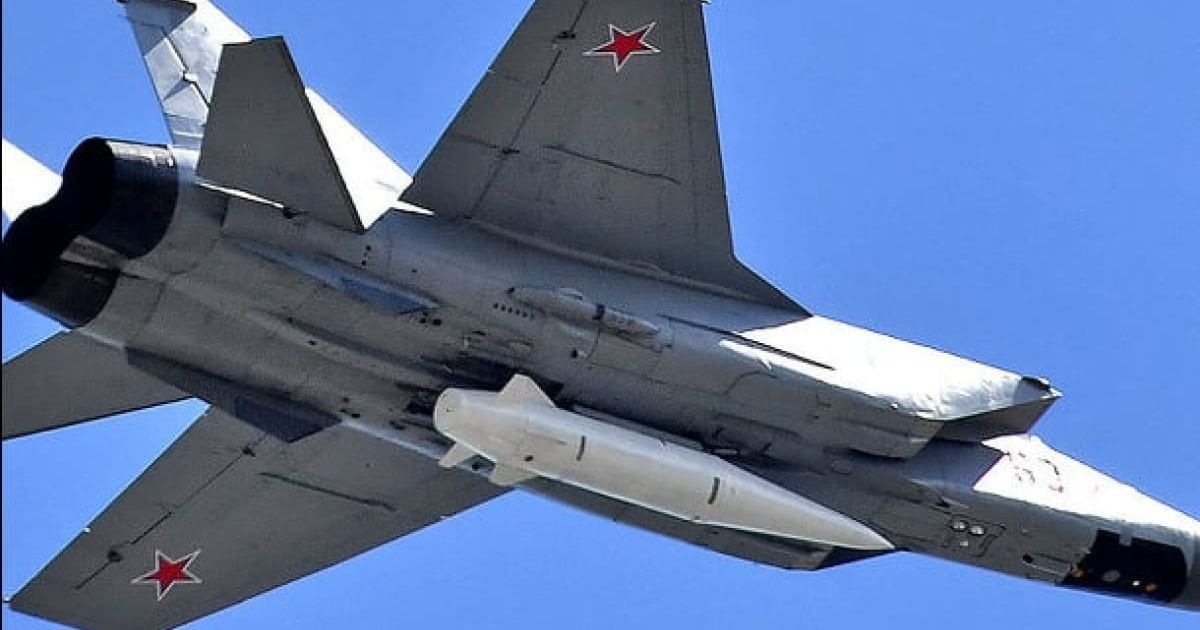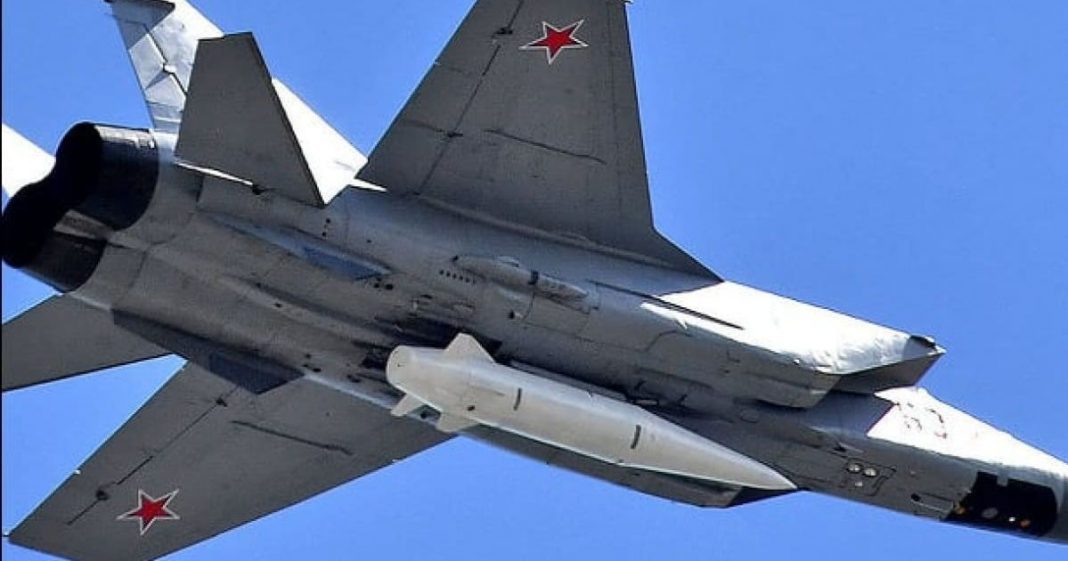
Friday, August 25, 2023 – 09:16 (EEST) Section: Analysis & Opinion, Latest news, Military, Photos
Air alarms are instantly activated across Ukraine when a MiG-31 carrying the Kh-47M2 Kinzhal takes off — a Russian air-launched ballistic missile capable of carrying a nuclear warhead. Espreso media outlet will tell the story of the development and characteristics of this missile, which, according to Russians, have “no analogues.”
The development history
Information about the development of the Kh-47M2 Kinzhal missile remains classified. However, there is information suggesting that this missile was possibly created based on the 9K720 Iskander-M when, in the 2010s, the Russian Federation began a program to modernize its military equipment. The developer is the Votkinsk Machine Building Plant, the same one that produced Iskander missiles. In terms of dimensions and size, these two missiles are similar.
All photos provided by Wikipedia
In 2017, the Kinzhal missile was adopted into service at airfields of the Southern Military District of the Russian Federation, although it was only publicly revealed in March 2018. This was done by the President of Russia, Vladimir Putin, once again attempting to demonstrate the “might” of the Russian army.
This supersonic missile cannot take off by itself; it requires a carrier aircraft. These carriers include the modified supersonic long-range interceptor MiG-31 (carrying one missile), as well as the strategic aviation aircraft Tu-22M3 (carrying four missiles), and potentially the Tu-160 (carrying 8 missiles). After being released, Kinzhal missile is capable of flying at hypersonic speeds while maneuvering. It was specifically designed to overcome enemy air defenses and to strike the designated target within a matter of minutes.
Characteristics and design of the Kinzhal missile
These missiles are the fastest in the Russian arsenal and can fly at hypersonic speeds (Russians claim they are 10 times the speed of sound, which is over 10,000 km/h or about 6,200 mph, although experts have doubts about this) and can maneuver during flight. The missile weighs 4.3 tons, with approximately 500 kg being the weight of the warhead. Its length is 7.2 meters, diameter is 1.2 meters, and the wingspan for flight stabilization is 1.6 meters.
Thanks to a powerful solid-fuel rocket engine, the missile can accelerate to speeds of 3-4 km per second when approaching the target. The maximum striking range is 2,000 km when launched from the MiG-31 or 3,000 km when launched from the Tu-22M3. The altitude at which it reaches hypersonic speed is 20 km. The accuracy when hitting the target is as precise as 1 meter.
The exact number of Kh-47M2 missiles produced is unknown. At the beginning of 2023, the Ukrainian Minister of Defense stated that Russia still possesses 53 of these missiles, and production has continued despite sanctions.
Similar missiles
KInzhal missiles are not an entirely new development; they are a modified version of the Iskander ballistic missile. They were adapted for launch from aircraft, which enables them to achieve higher launch speeds and extends their strike range. However, some experts argue that even though the KInzhal missile is technically a hypersonic missile, it is still considered outdated compared to modern developments like the Chinese DF-ZF or the American Hypersonic Attack, which can practically descend from space due to their flight altitude.
In NATO’s report on hypersonic weapons for the year 2020, it is mentioned that labeling the Kinzhal as a hypersonic missile is not appropriate. Despite Kremlin claims about its potential to reach speeds of up to Mach 10, NATO experts point out that this missile cannot travel at such speeds. Furthermore, a number of military analysts highlight that the KInzhal does not meet the criteria for hypersonic weapons, instead, it qualifies as an air-launched ballistic missile.
Where it was used
With the onset of full-scale war, Ukraine unfortunately became a testing ground for the entire arsenal of missile weapons from Russia, including Iskander, and Kalibr cruise missiles, Kh-101, Kh-55, Kh-555, and Kh-47M2 Kinzhal.
The first mention of the use of Kinzhal missiles in the war with Ukraine came from the Russian Ministry of Defense on March 18, 2022, claiming that they had destroyed an underground military storage facility in the Carpathian region. On May 9, 2022, three such missiles were launched from Tu-22M3 strategic aviation aircraft, targeting civilian objects in the Odesa region. This attack resulted in injuries to two people and the destruction of five tourist infrastructure facilities. At that time, the Pentagon stated that Russians had launched over 10 hypersonic missiles in the first three months of the full-scale war.
On August 7, 2022, during another missile strike by the Kinjal rockets, the Russian army targeted objects in the Vinnytsia region. On September 14, 2022, in the Stavropol Krai of the Russian Federation, near the village of Kendzhe-Kulak, a rocket fell for unknown reasons. During another missile strike on January 26, 2023, Russian military personnel used two MiG-31K aircraft to launch Kinzhal missiles at targets in Kyiv and Zaporizhzhia. A record number of Kinzhal missiles at once (6) were used during a massive missile strike on critical infrastructure objects in the night on March 8-9, 2023. On August 11, 2023, a report emerged about casualties and injuries in the Carpathian region due to an attack by a Kinzhal missile.
What is the danger of the Kinzhal missile?
The main danger posed by the Kh-47M2 Kinzhal lies in its speed and maneuverability. This makes it difficult to intercept by air defense systems. Some Russian military bloggers have referred to the Kh-47M2 as “impossible to shoot down.” However, as with many matters of “no analogs,” things didn’t turn out as anticipated.
Indeed, for a long time, Ukrainian air defense lacked the means to counter Kinzhal missiles. However, when the skies over Kyiv began to be defended by the American anti-aircraft missile system Patriot, the situation changed. On May 4, it was first reported that a successful interception of the Kinzhal missile had occurred. The Russian missile, launched from MiG-31K from Russian territory, was intercepted in the sky over Kyiv. This fact was also confirmed by US government sources and an official Pentagon spokesperson. Interestingly, this Kh-47M2 was supposedly designed to overcome the Patriot. Previously, it was believed that the American anti-aircraft system couldn’t shoot down Kinzhal missiles but it turned out to be capable after all. On May 16, 2023, the Ukrainian Armed Forces announced the downing of 27 aerial targets during a nighttime missile attack on Kyiv, including 6 Kinzhal missiles.
On August 12, the spokesperson of the Ukrainian Air Force, Yuriy Ignat, stated that since the beginning of Russia’s full-scale invasion, the Ukrainian air defense had successfully shot down a total of 14 aeroballistic missiles Kinzhal.
However, dozens of American Patriot air defense systems would be needed to cover the entire Ukrainian airspace and even that wouldn’t provide a 100% guarantee of intercepting Kinzhal missiles.
Therefore, when aircraft with these missiles take off, air alarms are activated across Ukraine to minimize potential casualties from impacts.
Originally posted by Yuriy Martynovych on Espreso. Translated and edited by the UaPosition – Ukrainian news and analytics website
See also: Russia managed to increase missile production several times despite Western sanctions







